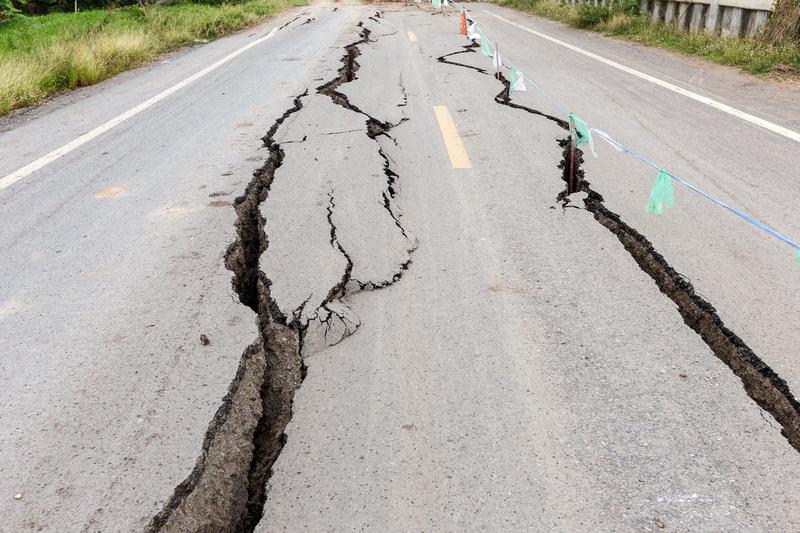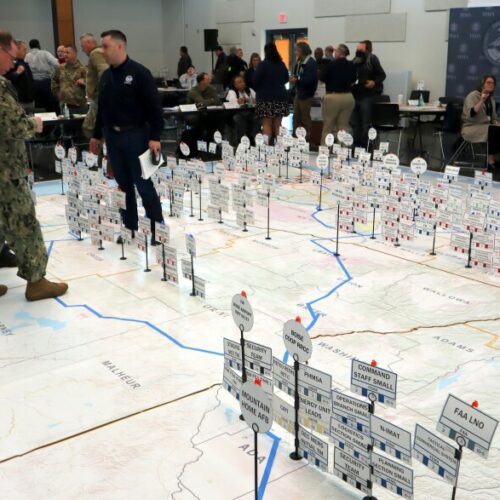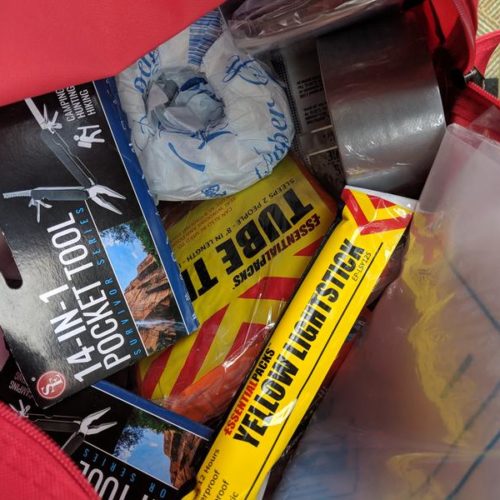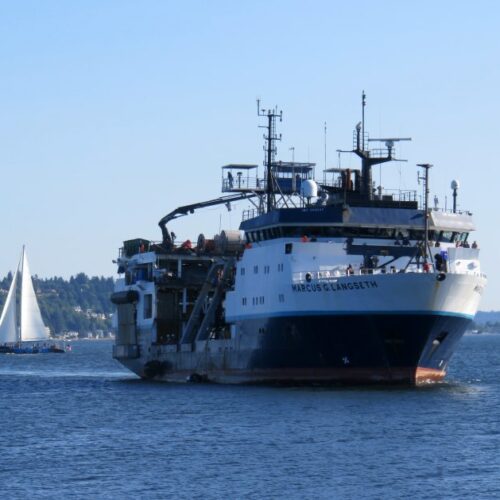
When ‘The Big One’ Hits The Northwest, What Could You Do With A Few Seconds Warning?
Listen
Smartphone users who opted in to a test of the West Coast earthquake early warning system got an early taste on Thursday of what is to come. Mobile phones from Seattle to Olympia blared with an alarm for imaginary incoming shaking. The earthquake warning system — already operational in California — will launch for the general public in Oregon on March 11 and statewide in Washington in May.
The earthquake early warning system is known as ShakeAlert. It doesn’t predict earthquakes. It’s designed to give a heads up about shaking coming from an earthquake that is underway. It works because electronic signals travel much faster than rumbling spreads through the earth’s surface.
After many years in development, the U.S. Geological Survey and its state partners say they are ready to let ShakeAlert issue automated mass public warnings in the Pacific Northwest. Thursday’s targeted public test in Western Washington showcased the potential and excitement for the system as well as the fact that there are still some glitches to work out.
“That’s it. Got it!” said Pacific Northwest Seismic Network director Harold Tobin, proudly holding up his smartphone to show viewers who joined a ShakeAlert test watch party that the alert came through seconds after transmission.
“Lovely!” enthused event moderator Mariah Jenkins of USGS, before other watch party participants piped up with their confirmations.
The ShakeAlert test used the same warning tones and distribution system as Amber Alerts, so the conversation was interspersed with the sounds of blaring alarms as the test message propagated across the cellular networks of King, Pierce and Thurston counties.
But at least a third of the participants in Tobin’s breakout room of the Zoom watch party didn’t get the test alarm or got it too late to be useful.
“A minute later and I still haven’t got my notification,” said a Seattle area man who opted into the test.
“I haven’t got mine either,” a woman who joined the event replied.
What to do if you get an earthquake early warning for real
If the region experiences a moderate to strong quake in the near future, a successful alert will say basically, “Earthquake detected! Drop, cover, hold on. Protect yourself.”
“This just gives you a few seconds of warning so that you can get to your safe area much quicker,” said Althea Rizzo, who works on earthquake preparedness at the Oregon Office of Emergency Management.
“What we recommend people do is drop, cover and hold on until the shaking stops. Then, if you are in the tsunami inundation zone on the coast, to start evacuating,” Rizzo said in an interview.
“If you’re driving in a car, the appropriate action would be to pull over and stop the car, if possible. If you’re in a building, stay in a building,” said Tobin. “Most injuries from earthquakes in the U.S. are not from the catastrophic collapse of a building but from falling objects — lights, ceiling tiles, etc.”
The Wireless Emergency Alert (WEA) system demonstrated on Thursday works automatically. You don’t need to sign up for anything. But if you want something fancier or that does more, you have some options now — with more on the way.
Newer smartphones running on the Android operating system now come with built-in quake detection and alerting software created by Google. Google’s on-screen “Drop, Cover and Hold” early warning message parallels the Wireless Emergency Alert version.
Then there’s the private company in southern California behind a free downloadable app called QuakeAlertUSA. Its version offers more info on screen, including a countdown timer for when shaking should arrive and the predicted magnitude of the incoming earthquake.
“There’s a potential to get many alerts,” said Robert de Groot, who coordinates ShakeAlert technical partnerships for the U.S. Geological Survey. “If you downloaded apps and have an Android-powered phone and you have enabled WEA on your phone, then you may get multiple alerts on your device.”
The reception gaps exposed in Thursday’s public test underscore why his agency’s philosophy is that duplication is OK so that at least one alert gets through when time is of the essence.
“We are very interested in people getting alerts through as many pathways as possible,” de Groot said in an interview. “I mean, every delivery pathway has its limitations.”
Other startups and private companies are developing devices and services that piggyback on ShakeAlert to automatically perform a shutdown or safety action in the few seconds to tens of seconds available. Rizzo said this arena has the potential for many powerful applications.
“Like raise the bay doors of fire departments or return elevators to the ground floor,” Rizzo said. “Or to inform doctors to pull the scalpels out of the patient. Or drop arms across bridges to make sure people can’t get onto bridges, but can get off of bridges before the shaking starts.”
Two engineering firms based in the Northwest have partnered with USGS to license ShakeAlert to harden municipal water systems. Bothell, Washington-based RH2 designs seismic shutoff valves so water reservoirs don’t drain out through broken mains after an earthquake. Woodinville, Washington-based Varius is marketing alert monitoring software that water and sewer system operators can use to automatically stop pumps, close valves and prevent spills.
How strong does a quake have to be to trigger a warning?
Commercial users can typically customize the threshold for triggering an earthquake alert response. Rizzo explained the mass public warning function of ShakeAlert has a combination threshold. The detected earthquake needs to be magnitude 5 or greater and the people to be notified should expect noticeable rocking, at a minimum.
Rizzo said the March 11 launch date for wireless mass alerts of incoming earthquakes in Oregon was chosen deliberately. The date coincides with the tenth anniversary of the magnitude 9.1 Great Tohoku earthquake and tsunami, which killed about 20,000 people in Japan. Many more lives were probably saved by the sophisticated warning systems pioneered in Japan beforehand.
The time leading up to Washington state’s launch, which is about two months later than Oregon’s, will allow for further fine tuning. In an interview posted by the University of Washington where Tobin teaches, he said the delayed launch will also give more time to “prepare the public by educating people on what the ShakeAlert Earthquake Early Warning system is, how to receive alerts, and how to protect themselves when they receive an alert.”
California rolled out ShakeAlert for the public first in late 2019. California has the most frequent earthquakes of the three participating states and the largest earthquake hazard.
The unified West Coast system took many years to build. The federal government in partnership with multiple universities and state agencies had to install hundreds upon hundreds of seismic sensors over known earthquake faults statewide in Washington, Oregon and California. Funding for this came in dribs and drabs from Congress, with occasional extra help from the states and foundations.
USGS said the seismic sensor network is now 70% complete for the West Coast, with 1,132 out of the planned 1,675 seismic stations installed as of last month.
Related Stories:

Rehearsing For ‘The Big One’ On A Room-Sized Chess Board
Close to 200 federal, state and tribal emergency preparedness planners gathered around a giant map of the Pacific Northwest this week to rehearse and critique the federal response plan for “The Big One.” The three-day Cascadia earthquake discussion exercise partially replaced a much bigger planned dress rehearsal that was canceled due to the coronavirus pandemic.

Are You ‘Two Weeks Ready’ For Post-Quake Survival? WA And OR Say You Should Be
The state of Oregon has set an ambitious goal to prepare more families in earthquake country to be “two weeks ready” after a disaster. Washington’s emergency management agency is also seeking more funding to prepare people in a similar way.

Seismic Research Ship Goes Boom-Boom To Seek Answers At Origin Of The Next Big One
Earthquake researchers are eager to dig into a trove of new data about the offshore Cascadia fault zone. When Cascadia ruptures, it can trigger a megaquake known as “the Big One.” The valuable new imaging of the geology off the Oregon, Washington and British Columbia coasts comes from a specialized research vessel.















